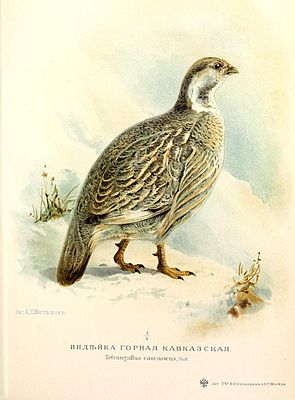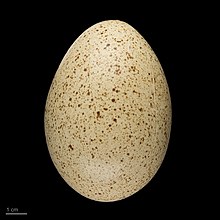Caucasian king chicken
| Caucasian king chicken | ||||||||||
|---|---|---|---|---|---|---|---|---|---|---|

Caucasian King's Chicken ( Tetraogallus caucasicus ) |
||||||||||
| Systematics | ||||||||||
|
||||||||||
| Scientific name | ||||||||||
| Tetraogallus caucasicus | ||||||||||
| ( Pallas , 1811) |
The Caucasus king chicken ( Tetraogallus caucasicus ), also written Caucasus king chicken , is a species of bird from the genus of the king fowl ( Tetraogallus ) in the family of the pheasants (Phasianidae), which belong to the order of the chicken birds (Galliformes). Its range is limited to the Greater Caucasus.
features
The Caucasian king chicken is between 50 and 60 cm long, very stoutly built with a large head, thick neck and long tail. The plumage is mostly drawn very finely gray, brown, white and black, so that it looks gray from a distance. The flanks are patterned more rusty brown and stronger black, while the chest and the coat are gray and finely mottled black. The neck is white with rust-brown stripes on the sides and on the nape of the neck. The under tail-coverts are white. In flight, a large white wing field can be seen both on the underside and on the top. The females are generally a little more dull in color than the males and the young are even paler and have no rust brown on the flanks. It also has a powerful, featherless barrel.
The chicks are similar to those of the Himalayan king chicken . They are pale cream-colored to slightly yellowish on the underside of the body. The top of the body is pale reddish beige with dark gray-brown and black spots and stripes.
In its area of distribution, the Caucasian king chicken cannot be confused with any other bird species. Its distribution area does not differ from any other species of the genus Königshühner.
distribution and habitat
It occurs exclusively in the Caucasus on free, steep and rocky slopes above the tree line between 2000 and 4000 meters above sea level. However, it still needs low vegetation as a source of food, which is why it can also occur at slightly lower altitudes in winter.
The habitat are slopes of different inclinations with rocks and scree fields, small meadows and groups of shrubs. During the summer half of the year, the Caucasian king hen prefers to stay on the northern slopes, while in winter it is more likely to be observed on the southern slopes. It stays in the same mountain range all year round, but undertakes small hikes, especially in the vertical direction. In March, for example, the Caucasian king grouse can be found at altitudes between 2300 and 2400 meters, because at this time the lower sections of the subalpine belt are cleared of snow. As the spring progresses, the Caucasian king chicken migrates further up and can be found in the middle of summer near the eternal snow at altitudes between 3500 and 4000 meters. With the onset of snowfall, the Caucasian king hen begins to migrate again to lower elevations.
behavior
Caucasian king fowl feed almost exclusively on vegetal basis. The spectrum of food plants hardly changes over the course of the year. It just shifts from fresh green parts, which are mostly eaten in spring and summer, to dry stems and seeds in the winter half-year. Almost 60 percent of the diet comes from three plants, namely the vetch, the meadow panicle and a lady's mantle species. Berries, on the other hand, are not eaten by the Caucasian king hen.
Caucasian Kings are monogamous birds. Outside of the breeding season, the Caucasian king hen forms small flocks. The separation of the couples from the troop begins at the end of March. Pairing and occupying the breeding grounds is associated with fights between the roosters. After snowy winters and prolonged cold weather in spring, the Caucasus king hen reproduces late and many of the females do not mate at all.
The nest is on bare ground and often contains 5-6 greenish eggs that are only hatched by the female. During the brood, the female leaves the nest on average only twice a day in order to take in food for around 20 minutes. The chicks hatch largely synchronously within a few hours. They grow up quickly and can fly as early as 15 to 20 days.
The Caucasian king hen is very shy and flies up early, only to disappear after a flight interrupted by short, explosive wing beats with long gliding distances behind a ridge falling like a stone. If it is undisturbed, it skilfully jumps up and down the rocky slopes.
supporting documents
literature
- Lars Svensson , Peter J. Grant, Killian Mullarney: The New Cosmos Bird Guide. All kinds of Europe, North Africa and the Middle East. Franckh-Kosmos Verlag, Stuttgart 1999, ISBN 3-440-07720-9 .
- RL Potapov, VE Fling (HRSG): Handbook of the birds of the Soviet Union. Volume 4: Galliformes, Gruiformes. Aula Verlag, Wiesbaden 1989, ISBN 3-89104-417-8
Single receipts
- ↑ Collin Harrison, Peter Castell: Young birds, eggs and nests of birds in Europe, North Africa and the Middle East. 2nd Edition. Aula, Wiebelsheim 2004, ISBN 3-89104-685-5 . P. 110
- ↑ Protopov & Fling, 1989, p. 80
- ↑ Protopov & Fling, 1989, p. 83
- ↑ Protopov & Fling, 1989, S. 81
- ↑ Protopov & Fling, 1989, p. 83
- ↑ Protopov & Fling, 1989, p. 82
- ↑ Collin Harrison, Peter Castell: Young birds, eggs and nests of birds in Europe, North Africa and the Middle East. 2nd Edition. Aula, Wiebelsheim 2004, ISBN 3-89104-685-5 . P. 110
Web link
- Tetraogallus caucasicus inthe IUCN 2013 Red List of Threatened Species . Listed by: BirdLife International, 2012. Retrieved February 6, 2014.
